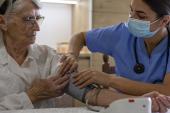In Female Veterans With Early ASCVD, Secondary Prevention Falls Short
A new study highlights the ongoing disparities in CVD healthcare for women, this time in veterans with premature disease.

Female veterans with premature atherosclerotic cardiovascular disease (ASCVD), as well as those with extremely premature disease onset, are much less likely to receive evidence-based medical therapy, including high-intensity statins, when compared with male veterans, a new Veterans Affairs (VA) study shows.
The study highlights, yet again, the historic disparities in cardiovascular healthcare for women, one that is now seen in young patients who “have a lot to lose” by being undertreated, according to senior investigator Salim Virani, MD, PhD (Michael E. DeBakey VA Medical Center/Baylor College of Medicine, Houston, TX).
“When you look at the data in secondary prevention—it holds true for primary prevention, as well—there is no heterogeneity of statin therapy by sex or by age,” he told TCTMD. “That’s never been shown. For [a woman] who is 40 or 45 years old and gets their first MI, the number of years that you can salvage without disability by providing therapy is large. We need to do a better job as clinicians to explain that to our patients. We need to tell them, if they’ve had an MI: ‘Right now, you have good functional capacity, but your second event might be a stroke or a second MI that leads to heart failure and we might not be as lucky to preserve your quality of life.’”
Stressing the importance of salvaging the largest number of disability-adjusted life years is relevant for all patients, but it might be particularly relevant for these younger people with premature ASCVD, especially if they are raising families, said Virani. “It would be devastating to them if they aren’t able to enjoy life to the fullest.”
These new data are disappointing but not surprising given what’s known about sex-based disparities in CVD care, sources told TCTMD.
“We have known about the undertreatment of women for some time and many of us have supported efforts to reverse this, but despite that, disparities remain,” said Karol Watson, MD, PhD (David Geffen School of Medicine at UCLA, Los Angeles), who was not involved in the study. “And one of the things we are seeing now is that outcomes among young women are getting worse rather than better.”
Avinainder Singh, MD (Yale University School of Medicine, New Haven, CT), who also commented on the findings, has published on the characteristics, management, and outcomes of patients who experience an MI at a young age in the YOUNG-MI registry. He said it’s now well documented that women are undertreated compared with men and that overall, for both groups, secondary prevention care appears to be lacking.
We need to go outside our usual thinking to look at social determinants of health as well. Salim Virani
“In general, patients in the VA do tend to get better care because it’s a closed loop system, most of the care is free, and they have long, trusting relationships with their physicians for the most part,” said Singh. “So this is real-world data in a closed healthcare system, and yet the numbers for medication use, such as for statins, are just abysmal. It pains me, because these are patients who are declaring themselves out in the world: ‘Hey, we’re the youngest, highest-risk patients for cardiovascular events. A heart attack, stroke, or heart failure will completely change my life, and this is an opportunity for you to treat me.’ And yet, we’re just letting these patients slip away.”
VITAL Registry of Premature ASCVD
The study, published April 21, 2021, in JAMA Cardiology, is an analysis of men and women in the nationwide VA healthcare system who are enrolled in the Veteran With Premature Atherosclerosis (VITAL) registry. Between 2014 and 2015, the researchers identified 147,600 veterans with premature ASCVD (ischemic heart disease, ischemic cerebrovascular disease, and peripheral artery disease), including 10,413 women and 137,187 men. Premature and extremely premature ASCVD was defined as the onset of disease in those ≤ 55 and ≤ 40 years, respectively.
Among the women with premature ASCVD, there was a higher percentage of African-American patients and a lower percentage of Asian patients when compared with men. Women also had a higher prevalence of ischemic cerebrovascular disease, but they were less likely to be obese and to have a history of hypertension, diabetes, ischemic heart disease, or peripheral artery disease. Women did have higher LDL-cholesterol levels than men, however (mean 155.0 vs 149.2 mg/dL).
When compared with men, women who had premature ASCVD were less likely to receive antiplatelet therapy, statins, and high-intensity statins. Undertreatment of women compared with men was seen across all ASCVD subtypes. Women with premature ASCVD and premature ischemic heart disease were also less likely to adhere to statin therapy than men, but there was no difference in statin adherence in women with ischemic cerebrovascular disease or peripheral artery disease.
Medication Use in US Veterans With Premature ASCVD and Ischemic Heart Disease
|
|
Women |
Men |
OR (95% CI) |
|
ASCVD |
|||
|
Any Antiplatelet |
61.3% |
79.2% |
0.59 (0.56-0.61) |
|
Statin |
57.5% |
75.1% |
0.66 (0.63-0.69) |
|
High-Intensity Statin |
23.5% |
38.1% |
0.64 (0.60-0.67) |
|
Ischemic Heart Disease |
|||
|
Any Antiplatelet |
64.0% |
82.5% |
0.47 (0.42-0.47) |
|
Statin |
63.1% |
78.4% |
0.62 (0.59-0.66) |
|
High-Intensity Statin |
28.7% |
41.8% |
0.63 (0.59-0.66) |
Similarly, in 9,485 patients with extremely premature ASCVD, women were significantly less likely to be treated with antiplatelets, statin therapy, and high-intensity statin therapy compared with men. Overall, just 29.0% of women with very early disease were treated with a statin, just one in 10 were on a high-intensity statin, and roughly one-third received antiplatelet therapy. For men, just 52.3% and 27.2% were taking a statin or high-intensity statin, respectively, and 56.5% were taking antiplatelet medication.
For extremely premature ASCVD, “the disparities between men and women are even more stark,” said Virani. And while there are gender disparities, men didn’t fare a lot better, he noted. So while there is a need to eliminate the disparity in care, there is also a need to get both men and women better treated with proven secondary-prevention medications, he said.
Addressing Disparities
The reasons why women with premature or extremely premature ASCVD are undertreated compared with men isn’t fully known, said Virani. Therapeutic inertia—where doctors are reluctant to initiate or escalate care—might explain things at the clinician level, with some doctors reluctant to use high-intensity statins in younger women, particularly those still in their childbearing years. On the patient side, women of childbearing age might be reluctant to take medication, too. Virani pointed out that in their analysis women tended to have a greater prevalence of depression and post-traumatic stress disorder than men.
“In prior studies of the VA healthcare system, women have definitely been noted to have low levels of social support,” he said. “These lifelong therapies require quite a bit of support. These are women are probably working and taking care of their families. They have a lot responsibility where they might be able to take good care of themselves.”
This is real world data in a closed healthcare system, and yet the numbers for medication use, such as for statins, are just abysmal. Avinainder Singh
Virani said that approaches to improve physician-directed care need to be sensitive to the fact clinicians can be bombarded with alerts and reminders, which can lead to fatigue. Helping them have conversations with patients, such as through cognitive support, would go a long way to improving use of guideline-directed medical therapies. These conversations need to touch on issues related to adherence, such as financial barriers or concerns about side effects, if they’re not taking the medication. “We need to go outside our usual thinking to look at social determinants of health, as well,” he said. “There are a lot of issues that need to be addressed.”
Implementation of guideline-directed medical therapy is a complicated science, said Singh, but it remains key not only to neutralizing the disparities in CVD care between men and women, but also in increasing use of medical therapy overall.
“One thing I think is key is that it’s easier to leverage technology in younger patients,” he said. “I think giving more power to patients through their medical records will probably change things”. He cited recent developments, such as the Cures Act, which will make it easier for patients to have access to their medical records, as well as portals like Epic’s MyChart and Apple’s Health Records, as steps in the right direction. “The problem is not just empowering patients, but also having physicians recognizing this as a problem,” said Singh. “That’s a larger issue. How do we get around that? That’s harder because it’s not like these patients weren’t seeing their primary care physician.”
Watson, who is the director of the UCLA Barbra Streisand Women’s Heart Health Program, said the typical approach to managing ASCVD risk is to recommend intensive lifestyle management and the prescription of “survival” medications, which include aspirin or other antiplatelet medications, statins, beta-blockers, and/or ACE inhibitors, because these drug classes have all been shown to lower the risk of cardiovascular mortality.
“We don’t know all the reasons for the undertreatment of women,” she said. “Some of it undoubtedly lies with doctors prescribing appropriate therapies less often.” In contrast with the present study, Watson said others have shown there is better adherence among women. She added that side effects, or concerns about side effects, might be part of the reason, too. She noted that there has been “mixed messaging” for women surrounding statin therapy even though the data are explicitly clear.
“For women with ASCVD, statin therapy is very beneficial,” she said.
Michael O’Riordan is the Managing Editor for TCTMD. He completed his undergraduate degrees at Queen’s University in Kingston, ON, and…
Read Full BioSources
Lee MT, Mahtta D, Ramsey DJ, et al. Sex-related differences in cardiovascular health care among patients with premature atherosclerotic cardiovascular disease. JAMA Cardiol. 2021;Epub ahead of print.
Disclosures
- Virani reports grant support from the US Department of Veterans Affairs, World Heart Federation, Tahir, and the Jooma Family Research Grant.
- Singh and Watson report no conflicts of interest.





Comments